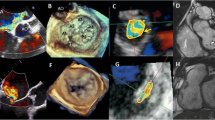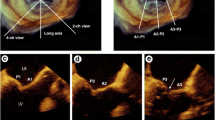Abstract
Mitral regurgitation (MR) is one of the most frequent indications for valve surgery in developed countries, and echocardiographic assessment is an essential tool to evaluate its etiologies, severity, and therapeutic indications. The mitral valve apparatus is a complex structure composed of several parts: apart from the mitral valve leaflets and annulus, it also includes the chordae tendineae, papillary muscles, and left ventricular (LV) wall. MR can be caused not only by organic changes of the mitral valve leaflets or chordae (primary MR) but also by extreme mitral annular enlargement or mitral leaflet tethering due to displacement and malfunction of papillary muscles and LV wall (secondary MR). In secondary MR with LV dysfunction, a milder degree of MR can be associated with adverse outcomes compared with primary MR. Grading the severity is the first step in evaluation of indication for surgical/transcatheter interventions. As such, there are several techniques to assess the severity of MR using echocardiography. However, none of the techniques is reliable enough by itself, and it is always recommended to integrate multiple methods. In cases where echocardiographic assessment of MR severity is inconclusive, magnetic resonance may be helpful. In addition to the severity, anatomical information, such as localization in primary MR due to mitral valve prolapse and LV size in secondary MR due to LV dilatation/dysfunction, is an important concern in presurgical echocardiography. Transesophageal echocardiography and three-dimensional echocardiography are key techniques for anatomical evaluation including mitral valve and LV volumes. In transcatheter intervention for MR, echocardiography plays a pivotal role as a guide for procedures and endpoints. In this review article, the authors provide a comprehensive summary of current standards of echocardiographic assessment of MR.







Similar content being viewed by others
References
Shimizu H, Endo S, Natsugoe S, et al. Thoracic and cardiovascular surgery in japan in 2016: annual report by the japanese association for thoracic surgery. Gen Thorac Cardiovasc Surg. 2019;67:377–411.
Adams DH, Rosenhek R, Falk V. Degenerative mitral valve regurgitation: best practice revolution. Eur Heart J. 2010;31:1958–66.
O’Gara PT, Grayburn PA, Badhwar V, et al. 2017 acc expert consensus decision pathway on the management of mitral regurgitation: a report of the american college of cardiology task force on expert consensus decision pathways. J Am Coll Cardiol. 2017;70:2421–49.
Zoghbi WA, Adams D, Bonow RO, et al. Recommendations for noninvasive evaluation of native valvular regurgitation: a report from the american society of echocardiography developed in collaboration with the society for cardiovascular magnetic resonance. J Am Soc Echocardiogr. 2017;30:303–71.
Nishino S, Watanabe N, Kimura T, et al. Acute versus chronic ischemic mitral regurgitation: an echocardiographic study of anatomy and physiology. Circ Cardiovasc Imaging. 2018;11:e007028.
Grigioni F, Enriquez-Sarano M, Zehr KJ, et al. Ischemic mitral regurgitation: long-term outcome and prognostic implications with quantitative doppler assessment. Circulation. 2001;103:1759–64.
Hepner AD, Ahmadi-Kashani M, Movahed MR. The prevalence of mitral valve prolapse in patients undergoing echocardiography for clinical reason. Int J Cardiol. 2007;123:55–7.
Theal M, Sleik K, Anand S, et al. Prevalence of mitral valve prolapse in ethnic groups. Can J Cardiol. 2004;20:511–5.
Kagiyama N, Toki M, Hayashida A, et al. Prolapse volume to prolapse height ratio for differentiating barlow’s disease from fibroelastic deficiency. Circ J. 2017;81:1730–5.
Barlow JB, Pocock WA. The significance of late systolic murmurs and mid-late systolic clicks. Md State Med J. 1963;12:76–7.
Carpentier A, Chauvaud S, Fabiani JN, et al. Reconstructive surgery of mitral valve incompetence: ten-year appraisal. J Thorac Cardiovasc Surg. 1980;79:338–48.
Otsuji Y, Handschumacher MD, Schwammenthal E, et al. Insights from three-dimensional echocardiography into the mechanism of functional mitral regurgitation: direct in vivo demonstration of altered leaflet tethering geometry. Circulation. 1997;96:1999–2008.
Otsuji Y, Handschumacher MD, Liel-Cohen N, et al. Mechanism of ischemic mitral regurgitation with segmental left ventricular dysfunction: three-dimensional echocardiographic studies in models of acute and chronic progressive regurgitation. J Am Coll Cardiol. 2001;37:641–8.
Nishino S, Watanabe N, Kimura T, et al. The course of ischemic mitral regurgitation in acute myocardial infarction after primary percutaneous coronary intervention: from emergency room to long-term follow-up. Circ Cardiovasc Imaging. 2016;9:e004841.
Gertz ZM, Raina A, Saghy L, et al. Evidence of atrial functional mitral regurgitation due to atrial fibrillation: reversal with arrhythmia control. J Am Coll Cardiol. 2011;58:1474–81.
Kagiyama N, Hayashida A, Toki M, et al. Insufficient leaflet remodeling in patients with atrial fibrillation: association with the severity of mitral regurgitation. Circ Cardiovasc Imaging. 2017;10:e005451.
Kagiyama N, Mondillo S, Yoshida K, et al. Subtypes of atrial functional mitral regurgitation: imaging insights into their mechanisms and therapeutic implications. J Am Coll Cardiol Img. 2019. https://doi.org/10.1016/j.jcmg.2019.01.040.
Baumgartner H, Falk V, Bax JJ, et al. 2017 esc/eacts guidelines for the management of valvular heart disease. Eur Heart J. 2017;38:2739–91.
Nishimura RA, Otto CM, Bonow RO, Carabello BA, et al. 2014 aha/acc guideline for the management of patients with valvular heart disease: a report of the american college of cardiology/american heart association task force on practice guidelines. Circulation. 2014;129:e521–643.
Thompson CR, Buller CE, Sleeper LA, et al. Cardiogenic shock due to acute severe mitral regurgitation complicating acute myocardial infarction: a report from the shock trial registry. J Am Coll Cardiol. 2000;36:1104–9.
Smyllie JH, Sutherland GR, Geuskens R, et al. Doppler color flow mapping in the diagnosis of ventricular septal rupture and acute mitral regurgitation after myocardial infarction. J Am Coll Cardiol. 1990;15:1449–55.
Roberts WC, Braunwald E, Morrow AG. Acute severe mitral regurgitation secondary to ruptured chordae tendineae: clinical, hemodynamic, and pathologic considerations. Circulation. 1966;33:58–70.
Enriquez-Sarano M, Avierinos JF, Messika-Zeitoun D, et al. Quantitative determinants of the outcome of asymptomatic mitral regurgitation. N Engl J Med. 2005;352:875–83.
Devereux RB, Kramer-Fox R, Shear MK, et al. Diagnosis and classification of severity of mitral valve prolapse: methodologic, biologic, and prognostic considerations. Am Heart J. 1987;113:1265–80.
Lancellotti P, Moura L, Pierard LA, Reviewers: D, Sicari R, Vahanian A, Roelandt JRTC., et al. European association of echocardiography recommendations for the assessment of valvular regurgitation. Part 2: Mitral and tricuspid regurgitation (native valve disease). Eur Heart J Cardiovasc Imaging. 2010;11:307–32.
Hall Shelley A, Brickner ME, Willett DuWayne L, et al. Assessment of mitral regurgitation severity by doppler color flow mapping of the vena contracta. Circulation. 1997;95:636–42.
Baumgartner H, Schima H, Kühn P. Value and limitations of proximal jet dimensions for the quantitation of valvular regurgitation: an in vitro study using doppler flow imaging. J Am Soc Echocardiogr. 1991;4:57–66.
Enriquez-Sarano M, Seward JB, Bailey KR, et al. Effective regurgitant orifice area: a noninvasive doppler development of an old hemodynamic concept. J Am Coll Cardiol. 1994;23:443–51.
Enriquez-Sarano M, Bailey KR, Seward JB. Quantitative doppler assessment of valvular regurgitation. Circulation. 1993;87:841–8.
Blumlein S, Bouchard A, Schiller NB, et al. Quantitation of mitral regurgitation by doppler echocardiography. Circulation. 1986;74:306–14.
Dujardin Karl S, Enriquez-Sarano M, Bailey Kent R, et al. Grading of mitral regurgitation by quantitative doppler echocardiography. Circulation. 1997;96:3409–15.
Uretsky S, Gillam L, Lang R, et al. Discordance between echocardiography and mri in the assessment of mitral regurgitation severity: a prospective multicenter trial. J Am Coll Cardiol. 2015;65:1078–88.
Uretsky S, Aldaia L, Marcoff L, et al. The effect of systolic variation of mitral regurgitation on discordance between noninvasive imaging modalities. J Am Coll Cardiol Img. 2019. https://doi.org/10.1016/j.jcmg.2019.02.014.
Tsang W, Weinert L, Sugeng L, et al. The value of three-dimensional echocardiography derived mitral valve parametric maps and the role of experience in the diagnosis of pathology. J Am Soc Echocardiogr. 2011;24:860–7.
Chandra S, Salgo IS, Sugeng L, Weinert L, Tsang W, Takeuchi M, Spencer KT, O’Connor A, Cardinale M, Settlemier S, Mor-Avi V, Lang RM. Characterization of degenerative mitral valve disease using morphologic analysis of real-time three-dimensional echocardiographic images: objective insight into complexity and planning of mitral valve repair. Circ Cardiovasc Imaging. 2011;4:24–32.
Tsang W, Salgo IS, Medvedofsky D, et al. Transthoracic 3d echocardiographic left heart chamber quantification using an automated adaptive analytics algorithm. JACC Cardiovasc Imaging. 2016;9:769–82.
Kagiyama N, Toki M, Hara M, et al. Efficacy and accuracy of novel automated mitral valve quantification: three-dimensional transesophageal echocardiographic study. Echocardiography. 2016;33:756–63.
Toki M, Kagiyama N, Maeda M, et al. Novel automated left heart chamber quantification software is useful for both beginners and experts: three-dimensional transthoracic echocardiographic study. J Am Soc Echocardiogr. 2017;30:B46.
Goebel B, Heck R, Hamadanchi A, et al. Vena contracta area for severity grading in functional and degenerative mitral regurgitation: a transoesophageal 3d colour doppler analysis in 500 patients. Eur Heart J Cardiovasc Imaging. 2018;19:639–46.
Schmidt FP, Gniewosz T, Jabs A, et al. Usefulness of 3d-pisa as compared to guideline endorsed parameters for mitral regurgitation quantification. Int J Cardiovasc Imaging. 2014;30:1501–8.
Nishimura RA, Otto CM, Bonow RO, et al. 2017 aha/acc focused update of the 2014 aha/acc guideline for the management of patients with valvular heart disease: a report of the american college of cardiology/american heart association task force on clinical practice guidelines. J Am Coll Cardiol. 2017;70:252–89.
Enriquez-Sarano M, Tajik AJ, Schaff HV, et al. Echocardiographic prediction of survival after surgical correction of organic mitral regurgitation. Circulation. 1994;90:830–7.
Badhwar V, Peterson ED, Jacobs JP, et al. Longitudinal outcome of isolated mitral repair in older patients: Results from 14,604 procedures performed from 1991 to 2007. Ann Thorac Surg. 2012;94:1870–7 discussion 1877-9.
Le Tourneau T, Richardson M, Juthier F, et al. Echocardiography predictors and prognostic value of pulmonary artery systolic pressure in chronic organic mitral regurgitation. Heart. 2010;96:1311–7.
Mentias A, Naji P, Gillinov AM, et al. Strain echocardiography and functional capacity in asymptomatic primary mitral regurgitation with preserved ejection fraction. J Am Coll Cardiol. 2016;68:1974–86.
Lancellotti P, Stainier PY, Lebois F, et al. Effect of dynamic left ventricular dyssynchrony on dynamic mitral regurgitation in patients with heart failure due to coronary artery disease. Am J Cardiol. 2005;96:1304–7.
Lancellotti P, Lebois F, Simon M, et al. Prognostic importance of quantitative exercise doppler echocardiography in asymptomatic valvular aortic stenosis. Circulation. 2005;112:I377–82.
Lancellotti P, Troisfontaines P, Toussaint AC, et al. Prognostic importance of exercise-induced changes in mitral regurgitation in patients with chronic ischemic left ventricular dysfunction. Circulation. 2003;108:1713–7.
Magne J, Lancellotti P, Pierard LA. Exercise pulmonary hypertension in asymptomatic degenerative mitral regurgitation. Circulation. 2010;122:33–41.
Wunderlich NC, Siegel RJ. Peri-interventional echo assessment for the mitraclip procedure. Eur Heart J Cardiovasc Imaging. 2013;14:935–49.
Zoghbi WA, Asch FM, Bruce C, et al. Guidelines for the evaluation of valvular regurgitation after percutaneous valve repair or replacement: a report from the american society of echocardiography developed in collaboration with the society for cardiovascular angiography and interventions, Japanese society of echocardiography, and society for cardiovascular magnetic resonance. J Am Soc Echocardiogr. 2019;32:431–75.
Komeda M, Koyama Y, Fukaya S, et al. Papillary heads “optimization” in repairing functional mitral regurgitation. J Thorac Cardiovasc Surg. 2012;144:1262–4.
Matsui Y, Shingu Y, Wakasa S, et al. Papillary muscle tugging approximation for functional mitral regurgitation. Ann Thorac Surg. 2019;107:e427–9.
Acker MA, Parides MK, Perrault LP, et al. Mitral-valve repair versus replacement for severe ischemic mitral regurgitation. N Engl J Med. 2013;370:23–32.
Shingu Y, Yamada S, Ooka T, et al. Papillary muscle suspension concomitant with approximation for functional mitral regurgitation. Circ J. 2009;73:2061–7.
Arai H, Itoh F, Someya T, et al. New surgical procedure for ischemic/functional mitral regurgitation: mitral complex remodeling. Ann Thorac Surg. 2008;85:1820–2.
Stone GW, Lindenfeld J, Abraham WT, et al. Transcatheter mitral-valve repair in patients with heart failure. N Engl J Med. 2018;379:2307–18.
Obadia JF, Messika-Zeitoun D, Leurent G, et al. Percutaneous repair or medical treatment for secondary mitral regurgitation. N Engl J Med. 2018;379:2297–306.
Pibarot P, Delgado V, Bax JJ. Mitra-fr vs. Coapt: lessons from two trials with diametrically opposed results. Eur Heart J Cardiovascular Imaging. 2019;20:620–4.
Author information
Authors and Affiliations
Corresponding author
Ethics declarations
Conflict of interest
The authors declare that there are no conflicts of interest.
Ethical statements
There are no ethical issues to disclose (the article is not original research).
Additional information
Publisher's Note
Springer Nature remains neutral with regard to jurisdictional claims in published maps and institutional affiliations.
About this article
Cite this article
Kagiyama, N., Shrestha, S. Echocardiographic assessment of mitral regurgitation. J Med Ultrasonics 47, 59–70 (2020). https://doi.org/10.1007/s10396-019-00971-1
Received:
Accepted:
Published:
Issue Date:
DOI: https://doi.org/10.1007/s10396-019-00971-1




